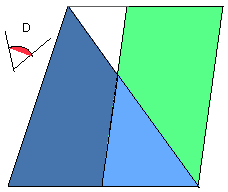To construct, in a given rectilineal angle, a parallelogram equal to a given triangle.
 Let ABC be the given triangle, and D the given rectilineal angle;
Let ABC be the given triangle, and D the given rectilineal angle;
 thus it is required to construct in the rectilineal angle D a parallelogram
equal to the triangle ABC.
thus it is required to construct in the rectilineal angle D a parallelogram
equal to the triangle ABC.
 Let BC be bisected at E, and let AE be joined;
Let BC be bisected at E, and let AE be joined;
 on the straight line EC, and at the point E on it, let the angle CEF be
constructed equal to the angle D;
on the straight line EC, and at the point E on it, let the angle CEF be
constructed equal to the angle D;
 through A let AG be drawn parallel to EC, and through C let CG be drawn
parallel to EF.
through A let AG be drawn parallel to EC, and through C let CG be drawn
parallel to EF.
Then FECG is a parallelogram.
 And, since BE is equal to EC,
And, since BE is equal to EC,
 the triangle ABE is also equal to the triangle AEC, for they are on equal
bases BE, EC and in the same parallels BC, AG;
the triangle ABE is also equal to the triangle AEC, for they are on equal
bases BE, EC and in the same parallels BC, AG;
 therefore the triangle ABC is the double of the triangle AEC.
therefore the triangle ABC is the double of the triangle AEC.
 But the parallelogram FECG is also double of the triangle AEC, for it has
the same base with it and is in the same parallels with it;
But the parallelogram FECG is also double of the triangle AEC, for it has
the same base with it and is in the same parallels with it;
 therefore the parallelogram FECG is equal to the triangle ABC.
therefore the parallelogram FECG is equal to the triangle ABC.
 And it has the angle CEF equal to the given angle D.
Therefore the parallelogram FECG has been constructed equal to the given
triangle ABC, in the angle CEF which is equal to D.
And it has the angle CEF equal to the given angle D.
Therefore the parallelogram FECG has been constructed equal to the given
triangle ABC, in the angle CEF which is equal to D.
Q.E.F